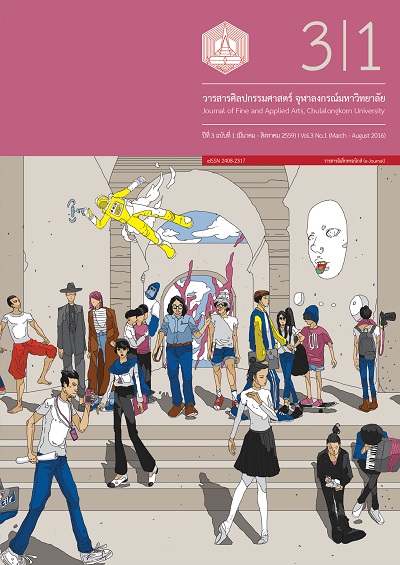วิเคราะห์ลักษณะของเพลงมอญเกาะเกร็ดในวงปี่พาทย์มอญคณะแหยมศิลป์
Keywords:
ปี่พาทย์มอญเกาะเกร็ด, แหยมศิลป์ Piphat Mon, Yam-silpaAbstract
บทคัดย่อ
บทความวิจัยนี้ มีวัตถุประสงค์เพื่อศึกษาความเป็นมาและสถานภาพบทบาทของวงดนตรี ปี่พาทย์มอญคณะแหยมศิลป์ และศึกษาลักษณะของบทเพลงในวงปี่พาทย์มอญคณะแหยมศิลป์ ที่เป็นเอกลักษณ์ของตำบลเกาะเกร็ด อำเภอปากเกร็ด จังหวัดนนทบุรี โดยใช้ระเบียบวิธีวิจัยเชิงคุณภาพ
ผลการวิจัยพบว่า ครูแหยม รนขาว ได้รับการสืบทอดทางเพลงมอญดั้งเดิม มาจากครูจำปา ซึ่งเป็นครูปี่พาทย์ดั้งเดิมของเกาะเกร็ด เมื่อครูจำปาเสียชีวิต ครูแหยมจึงตั้งวงชื่อ วงแหยมศิลป์ โดยรับเครื่องดนตรีของวงครูจำปามาทั้งชุด ต่อมาครูสมจิตต์ รนขาว ซึ่งเป็นบุตรชายก็ได้รับช่วงสืบต่อ วงปี่พาทย์มาจากครูแหยม เมื่อครูสมจิตต์เสียชีวิต นางทองทรัพย์ รนขาว (ปัจจุบันถึงแก่กรรม) ผู้เป็นภรรยาและลูกๆ เป็นผู้รับผิดชอบดูแลวงต่อมา และยังคงยึดแบบแผนการบรรเลงแบบมอญเก่าเคร่งครัด วงดนตรีแหยมศิลป์ จึงมีชื่อเสียงโด่งดังในเกาะเกร็ดเป็นที่รู้จักยอมรับนับถือในฝีมือและความเป็นของแท้ในการบรรเลงเพลงมอญที่สมบูรณ์แบบ ได้รับการว่าจ้างให้ไปบรรเลงในงานต่าง ๆ ของทางวัดและทางราชการ
ลักษณะของบทเพลงในวงปี่พาทย์มอญคณะแหยมศิลป์ เพลงประจำวัด เพลงประจำบ้าน เพลงเชิญ 2 ชั้น และเพลงพญาลิงขาวที่ผู้วิจัยเลือกศึกษา พบว่า สังคีตลักษณ์ของเพลงประจำวัดมีลักษณะการบรรเลงไม่ซ้ำทำนองเดิมซึ่งมีความแตกต่างกับคณะอื่นที่จะบรรเลงซ้ำในประโยคที่ 9 ส่วนเพลงประจำบ้าน เพลงเชิญ 2 ชั้นและเพลงพญาลิงขาวมีลักษณะสังคีตลักษณ์เหมือนเพลงมอญที่บรรเลงทั่วไป ด้านบันไดเสียงของเพลงทั้ง 4 เพลงใช้ 3 บันไดเสียง คือ บันไดเสียงเพียงออล่าง บันไดเสียงเพียงออบน และบันไดเสียงชวา โดยบันไดเสียงเพียงออบนเป็นบันไดเสียงหลักของทั้ง 4 เพลง การใช้ขั้นคู่เสียง มีการบรรเลงโดยใช้ขั้นคู่ 2 ถึงขั้นคู่ 11 โดยทั้ง 4 เพลงมีการทำเสียงคู่ 5 (คู่เสนาะ) ด้วยการใช้มือคู่ 4 การตีเสียงประสานคู่ 8 ด้วยมือคู่ 6 และคู่ 7 โดยพบเป็นจำนวนมากที่สุด และมีการทำเสียงคู่ 3 ซึ่งเป็นคู่เสนาะด้วยการใช้มือคู่ 2 มีการใช้มือขั้นคู่ 9 ขั้นคู่ 10 และขั้นคู่ 11 ในลักษณะมือถ่างด้วย กลวิธีการบรรเลง พบการตีคู่ประสาน การตีสลับมือตามแบบฉบับฆ้องมอญ การตีสะบัดขึ้น สะบัดลง การสะเดาะ มีการแบ่งมือในการบรรเลง 16 รูปแบบ ลักษณะการดำเนินทำนอง พบทำนองที่ปรุงแต่งมาจากลูกเท่าแต่ยังคงรูปแบบการยืนเสียง และพบว่าทั้ง 4 เพลง มีรูปแบบการดำเนินทำนองส่วนต้นวรรคท้า ส่วนท้ายวรรครับและลักษณะลูกตกจำนวน 15 รูปแบบ
Abstract
This article aims to study the history and status of Yam-silpa Piphat Mon troupe and the identity of the Troupe’ s repertoires which is unique to the Piphat Mon music of Koh Kret Island in Nonthaburi Province. Qualitative research methodology was used. The research found that Khru Yam Ronkhao received his training in the traditional Mon mode from Khru Champa, a master in traditional Pipat music of Koh Kret Island. After the passing of Khru Champa, Khru Yam inherited his entire set of musical instruments and set up his own troupe under the name of Yam-silp. The troupe was subsequently inherited by his son, Khru Somjit. After Khru Somjit’s death, his wife, Thongsup Ronkhao (now deceased), and children have been in charge of the troupe. With strict adherence the traditional Mon style of music, Yam-silpa Troupe has gained wide recognition in Koh Kret for its outstanding musical expertise and authentic style of Mon music. It has been frequently commissioned to play in temple and government functions.
The researcher chose to study four specific repertoires of the Yam-silpa Troupe: Pracham Wat, Pracham Baan, Chern Sawng Chan, and Phya Ling Khao. For Pracham Wat repertoire, it was found that Yam-silpa Troupe has a unique form of playing with no repetitive patterns for the entire repertoire while other troupes usually have a repetition of the 9 th sentence. Pracham Baan, Chern Song Chan, and Phya Ling Khao repertoires share similar musical forms to ordinary Mon repertoires. Three scales -- Phiang Aw Bon, Phiang Aw Lang, and Chawa -- are found in all four repertoires, with Piang Aw Bon being the principal scale. Varying degrees of intervals, from the 2nd to the 11th, are used. In the four repertoires under this study, the 5th and 4th dissonant intervals (Koo Sanoh) and the 8th and 6th harmony intervals are executed with the hands kept together. The 7th interval was found to be the most executed interval in these repertoires. The 3rd and 2nd intervals, also dissonant intervals, are executed with the hands kept together while the 9th, 10th and 11th intervals are executed with the hands in separate positions. The playing techniques include simultaneous striking with both hands, the Mon style alternate hand striking, Sabat Khuen (upward slide), Sabat Long (downward slide), and Sadoh striking. 16 styles of hand movement were identified. The melodies of these repertoires are the adapted versions of Look Thao technique with the traditional form of emphasizing certain melodic pitches retained. The opening melodies of the first half of a phrase are imitated by the second half. A total of 15 Look Tok playing styles was also found.
Downloads
Additional Files
Published
Issue
Section
License
ลิขสิทธิ์ของบทความเป็นของเจ้าของบทความ บทความที่ได้รับการตีพิมพ์ถือเป็นทัศนะของผู้เขียน
กองบรรณาธิการไม่จำเป็นต้องเห็นด้วยและไม่รับผิดชอบต่อบทความนั้น






